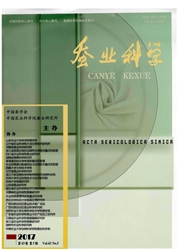

 中文摘要:
中文摘要:
利用基因重组技术合成了具有良好细胞粘附活性的重组家蚕丝素-RGD融合蛋白质(Silk-RGD),探讨了其盐析的工艺条件。研究发现,在融合蛋白等电点pH8附近,当硫酸铵在溶液中的饱和度较低(10%)时,其蛋白质沉淀量随着温度的升高而增加;当硫酸铵的饱和度升至20%时,蛋白质沉淀量不再随着温度的变化而变化,但与低饱和度硫酸铵时相比,沉淀量明显增加;当硫酸铵的饱和度升至30%或以上时,沉淀中杂蛋白含量明显增多,不利于目的蛋白的纯化。Silk—RGD融合蛋白相对合理而且易操作的盐析纯化条件为:pH8,硫酸铵在溶液中的饱和度为20%,室温(约20℃)。利用该工艺条件,可以低成本、高效率地生产Silk—RGD融合蛋白,从而满足新型材料规模化开发的需要。
 英文摘要:
英文摘要:
By applying of genetic engineering strategies a Bombyx mori silk fibroin-RGD fusion protein (Silk-RGD) was synthesize, which showed a high cell adhesive ability, and the technological conditions for saltingout purification of the Silk-RGD were studied. The results revealed that the yield of salting-out precipitate increased with rise of temperature at the low (NH4)2SO4 concentration (10%) under pH 8 of isoelectric point; when the (NH4)2SO4 concentration increased to 20%, the yield was not temperature-dependent but much more than that at concentration of 10% ; when the ( NH4)2SO4 concentration increased to 30% or above, there were many impurities in the precipitates causing difficulties for purification of the target protein. As a conclusion, it seemed that the rational and easy operating salting-out conditions for purification of Silk-RGD were 20% of(NH4)2SO4 at room temperature (around 20 ℃) and pH 8. Under these conditions, Silk-RGD can be produced with high efficiency and low cost to meet the demands of development of new material in large scale.
 同期刊论文项目
同期刊论文项目
 同项目期刊论文
同项目期刊论文
 期刊信息
期刊信息
